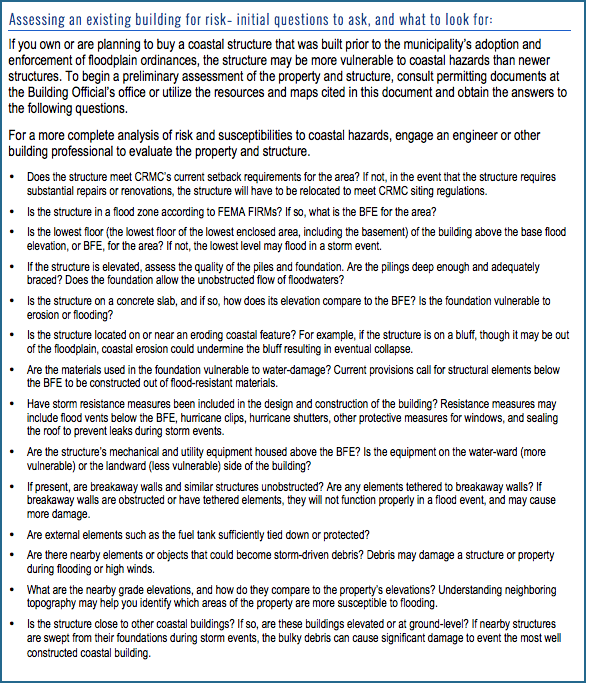Assessing Risk for Existing Buildings
8. How do I determine if the buildings on the property meet the current design and construction standards for the flood zone?
Many homes along the coast were built before the institution of the National Flood Insurance Program (NFIP), and therefore prior to a community’s first floodplain management code, ordinance, or standard. Since the adoption of the earliest flood insurance rate maps (FIRMs) in the mid-1970s, provisions designed to increase the flood-resistance of coastal structures have been strengthened within international, federal, and state building codes to meet the requirements of the NFIP.
In addition to the setbacks discussed in relation to coastal features and buffer zones (see Question 1: What kinds of coastal features are on or near the property, and what kinds of setbacks or regulations apply?), buildings in the coastal zone are required to meet certain standards in regards to design, construction, and siting. For example, in accordance with the NFIP, Rhode Island State Building Code requires that new and substantially improved structures in flood-prone areas be elevated at least one foot above the base flood elevation (BFE) for the area, and that all building components below BFE be constructed with flood-resistant materials.
Why it matters: If there is an older building on a coastal property, the structure may be more prone to damage from coastal hazards as a result of being built to less stringent codes.
To begin to assess the property, consult the list of questions on the following page. For a more detailed assessment, owners should engage an engineer or other building professional to evaluate the property to determine structural vulnerabilities.
Additionally, owners and potential buyers of coastal buildings can contact the municipality’s building official to get information on any permits that were required or issued to the previous owners documenting any repairs or renovations. These records can indicate how the structures were built, if they were ever updated, and measures were taken to increase structural resiliency.
Find out more: For more information about building standards in the floodplain, please see Section 300.3, Part G – Guidelines for Construction in Flood Hazard Zones in the CRMC regulations, and the resources listed in Question 10 of this document, Can I make the existing building more resilient? How do I build a new resilient structure? For information about flood-resistant building features, refer to the Floodplain Management in Rhode Island: 2007 Quick Guide.

NEXT: Septic System Requirements for the Coastal Zone >>
This website has been prepared by the University of Rhode Island’s Coastal Resources Center and Rhode Island Sea Grant for the R.I. Coastal Resources Management Council as a guidance resource. It is not intended nor should be used to give any legal advice nor to supersede any state or federal statutory or regulatory language or interpretation of such language. This website refers the reader to various regulations and policies adopted by federal and state regulatory agencies; the reader is encouraged to review the specific regulation and policy.
Rhode Island Coastal Property Guide Credits & Acknowledgements
